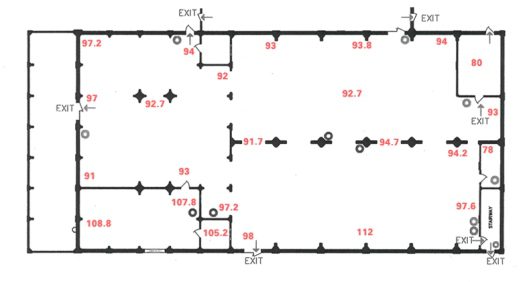If you require a noise mapping survey like those discussed in this article, call us at 973-366-4660 or e-mail us at info@atlenv.com for details and a free estimate.
Published on February 3, 2020; August 2021
An Industrial Noise Map Is Basic to Hearing Conservation and Community Noise Regulations
In the United States, OSHA has set regulations on worker noise exposure. The specific regulations are 29 CFR 1910.95 for Industry and 29 CFR 1926.52 for Construction.
Usually, noise within the workplace is measure by attaching a portable noise dosimeter to a worker. This allows the dosimeter to measure noise exposure as the person moves about the work area. However, this does not identify the source and location of the noise. It also does not address non-OSHA noise issues such as community noise, noise frequencies, or noise control. Therefore, when conducting a noise survey, a noise map is the most useful means of identifying noise sources and where noise exposure may be greatest.
The most useful starting point is a floor plan of the workspace or the property where measurements are taken. Specific noise readings can be logged on the floor plan. Since few industrial settings have steady static noise, it is usually best to list both 1) the average noise level, and 2) the range of noise from low to high. Then, make sure that the readings are in the same settings as the noise dosimeters—usually dB (A scale) slow response noise map.

A noise map is valuable in that it gives us both the ability to identify the noise levels that contribute to a worker’s cumulative exposure AND it indicates where noise reduction efforts need to be focused to achieve OSHA compliance and reduce the possibility of work-related hearing loss among employees. (Reminder: The OSHA noise standard is 29 CFR 1910.95 for Industry and 29 CFR 1926.52 for Construction).
In short, for community noise complaints or local noise ordinance requirements, a noise map is the essential solution.
Noise Survey
During the noise survey, it may be necessary to gather additional details regarding noise (such as octave band analysis) to identify specific frequencies that are contributing to the noise. This is critical since most noise reduction methods and materials are frequency specific. This applies to both OSHA Noise Regulation issues and community noise.
Hearing Conservation
I firmly believe that any Hearing Conservation effort in a commercial setting must include both noise dosimetry and noise mapping as the minimum effort to effectively control worker noise exposure. These efforts can be added to other hearing conservation activities such as audiometric testing/sampling, hearing protection, worker training, and noise central engineering.

Written by Robert E. Sheriff, CIH, CSP
Robert E. Sheriff is the CEO of Atlantic Environmental. A Certified Industrial Hygienist and Certified Safety Specialist, he has over thirty years of experience providing industrial hygiene and occupational safety services. To discuss your particular needs and obtain a complimentary proposal, contact him at 973-366-4660, email him at info@atlenv.com or fill out our contact form.
Our primary service areas are New Jersey NJ, New York NY, (New York City), Pennsylvania PA, Connecticut CT, Delaware DE, Massachusetts, (Boston) MA, Rhode Island RI, Washington DC, Wisconsin WI, Maryland MD, Michigan MI, Illinois (Chicago) IL, Virginia VA, Indiana IN, Georgia (Atlanta) GA, Alabama AL, North Carolina NC, South Carolina SC, Tennessee TN, Texas (Dallas, Ft Worth) TX, Oklahoma OK, DC, Arkansas AR, Florida FL. We can service most other areas of the U.S. but additional travel charges will be applied.



